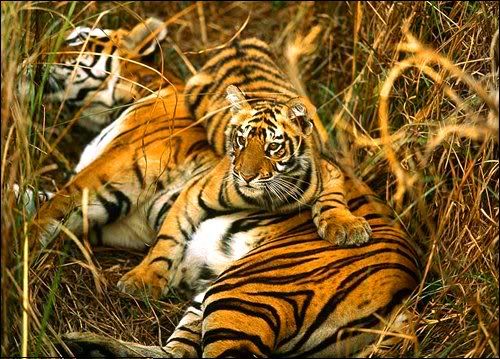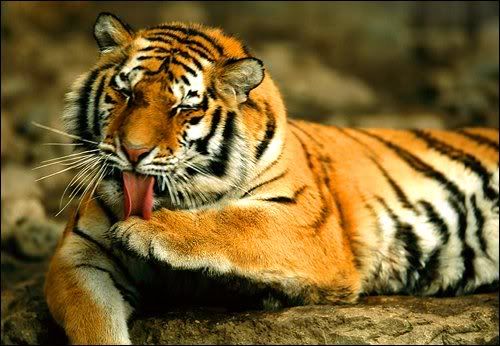|
|
Tiger
Apr 14, 2009 15:17:18 GMT -5
Post by Revenge on Apr 14, 2009 15:17:18 GMT -5
Tigers
No Two Exactly Alike: Tigers are the largest members of the cat family. Their coat is orange with black stripes; however, color intensity and the pattern of markings can vary according to species. The Sumatran tiger is the smallest and darkest of the subspecies, and the Siberian is the largest and lightest in color. No two tigers are exactly alike.
Imminent Extinction: At one time, nine subspecies made up the tiger family, but since the 1950s three to four have gone extinct. The remaining species are endangered due to poaching, loss of habitat and loss of prey due to overhunting by humans.
A Night Hunter: The tiger is a night hunter and can easily take down large animals, such as deer, wild pigs and cattle. Small animals are also sometimes on the menu.
An Awesome Appetite: Tigers can eat up to 90 pounds in a single sitting. After a big meal, they don't have to eat again for up to two weeks.
DID YOU KNOW?
Adding and Subtracting: In 2004, the Malayan tiger was identified as a tiger subspecies. The number of living subspecies, however, will likely remain at five with the recent extinction of the South China tiger. Other extinct subspecies include the Caspian, Javan and Balinese tigers.
Boxed In: The tiger's ability to adapt to a variety of habitats isn't enough to save it from extinction; it requires large, contiguous areas of habitat and lives in some of the most densely populated places on earth.
Javan Origins?: The earliest known fossils of true tigers, dating to around 1.7 million years ago, come from the island of Java in Indonesia, suggesting that the cat evolved there before radiating out. |
|
|
|
Tiger
Apr 14, 2009 15:26:48 GMT -5
Post by Revenge on Apr 14, 2009 15:26:48 GMT -5
The Bengal Tiger
Bengal Tiger Profile
Tigers are the largest members of the cat family and are renowned for their power and strength.
There were eight tiger subspecies at one time, but three became extinct during the 20th century. Over the last 100 years, hunting and forest destruction have reduced tiger populations from hundreds of thousands of animals to perhaps fewer than 2,500. Tigers are hunted as trophies, and also for body parts that are used in traditional Chinese medicine. All five remaining tiger subspecies are endangered, and many protection programs are in place.
Bengal tigers live in India and are sometimes called Indian tigers. They are the most common tiger and number about half of all wild tigers. Over many centuries they have become an important part of Indian tradition and lore.
Tigers live alone and aggressively scent-mark large territories to keep their rivals away. They are powerful nocturnal hunters that travel many miles to find buffalo, deer, wild pigs, and other large mammals. Tigers use their distinctive coats as camouflage (no two have exactly the same stripes). They lie in wait and creep close enough to attack their victims with a quick spring and a fatal pounce. A hungry tiger can eat as much as 60 pounds (27 kilograms) in one night, though they usually eat less.
Despite their fearsome reputation, most tigers avoid humans; however, a few do become dangerous maneaters. These animals are often sick and unable to hunt normally, or live in an area where their traditional prey has vanished.
Females give birth to litters of two to six cubs, which they raise with little or no help from the male. Cubs cannot hunt until they are 18 months old and remain with their mothers for two to three years, when they disperse to find their own territory.
Bengal Tiger Range (In the yellow)
Fast Facts
Type: Mammal
Diet: Carnivore
Average lifespan in the wild: 8 to 10 years
Size: Head and body, 5 to 6 ft (1.5 to 1.8 m); Tail, 2 to 3 ft (0.6 to 0.9 m)
Weight: 240 to 500 lbs (109 to 227 kg)
Did you know?: A tiger's roar can be heard as far as two miles (three kilometers) away.
Protection status: Endangered
Size relative to a 6-ft (2-m) man 
|
|
|
|
Tiger
Apr 14, 2009 15:31:05 GMT -5
Post by Revenge on Apr 14, 2009 15:31:05 GMT -5
The Siberian Tiger
Siberian Tiger Profile
Siberian (or Amur) tigers are the world's largest cats. They live primarily in eastern Russia's birch forests, though some exist in China and North Korea. There are an estimated 400 to 500 Siberian tigers living in the wild, and recent studies suggest that these numbers are stable. Though their northern climate is far harsher than those of other tigers, these animals have some advantages. Northern forests offer the lowest human density of any tiger habitat, and the most complete ecosystem. The vast woodlands also allow tigers far more room to roam, as Russia's timber industry is currently less extensive than that of many other countries.
Tigers are the largest of all wild cats and are renowned for their power and strength. There were once eight tiger subspecies, but three became extinct during the 20th century. Over the last 100 years, hunting and forest destruction have reduced overall tiger populations from hundreds of thousands to perhaps 5,000 to 7,000. Tigers are hunted as trophies and also for body parts that are used in traditional Chinese medicine. All five remaining tiger subspecies are endangered, and many protection programs are in place. Poaching is a reduced—but still very significant—threat to Siberian tigers.
Tigers live alone and aggressively scent-mark large territories to keep their rivals away. They are powerful hunters that travel many miles to find prey, such as elk and wild boar, on nocturnal hunts. Tigers use their distinctive coats as camouflage (no two have exactly the same stripes) and hunt by stealth. They lie in wait and creep close enough to attack their victims with a quick spring and a fatal pounce. A hungry tiger can eat as much as 60 pounds (27.2 kilograms) in one night, though they usually eat less.
Despite their fearsome reputation, most tigers avoid humans; however, a few do become dangerous maneaters. These animals are often sick and unable to hunt normally, or live in areas where their traditional prey has vanished.
Females give birth to litters of two to six cubs, which they raise with little or no help from the male. Cubs cannot hunt until they are 18 months old, and remain with their mothers for two to three years, when they disperse to find their own territory.
Siberian Tiger Range (In the yellow)
Fast Facts
Type: Mammal
Diet: Carnivore
Size: 10.75 ft (3.3 m)
Weight: 660 lbs (300 kg)
Protection status: Endangered
Size relative to a 6-ft (2-m) man 
|
|
|
|
Tiger
Apr 14, 2009 15:31:20 GMT -5
Post by Revenge on Apr 14, 2009 15:31:20 GMT -5
|
|








